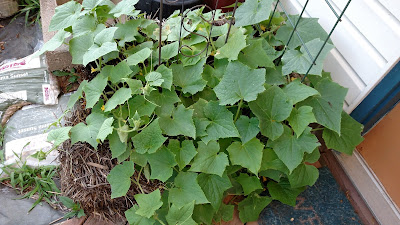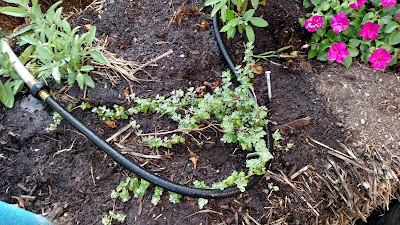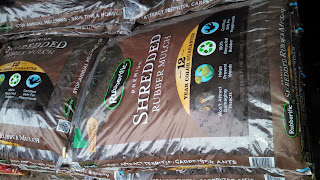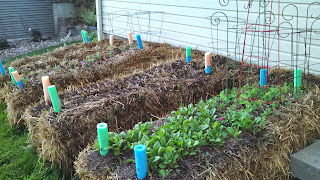Straw Bale Gardening: Conditioning Straw Bales
This is article two in my series about Straw Bale Gardening- in this article, you'll learn all about conditioning straw bales for a straw bale garden. See my
first article on Straw Bale Gardening to learn how to find straw bales and how to lay out a straw bale garden.
If you want to learn all about straw bale gardens, you can learn everything from planning through harvest:
Steps for Conditioning Straw Bales for Straw Bale Gardening
- Day 1: 3 cups composted fertilizer per bale and water
- Day 2: water
- Day 3: 3 cups composted fertilizer per bale and water
- Day 4: water
- Day 5: 3 cups composted fertilizer per bale and water
- Day 6: water
- Day 7: 1.5 cups composted fertilizer per bale and water
- Day 8: 1.5 cups composted fertilizer per bale and water
- Day 9: 1.5 cups composted fertilizer per bale and water
- Day 10: 3 cups bone meal/wood ash mix (supplies phosphorus and potassium), and water
Here is a link to an article in
Modern Farmer that describes this method for conditioning straw bales.
During the conditioning process, the straw bale will heat up to over 100 degrees, which kills most of the weed seeds that may be mixed in with the straw. Some people use hay bales instead of straw bales, but I would be a little concerned about weed seeds even with the heating of the bales. Since the bale heats up, you will need to wait until the bales cool down to plant your seeds or plants that you have started in the bales. I am not sure yet if I will just stick my hand in the bale to see if it is warm, or if I will use a thermometer.
We should be ready to plant some of the hardier vegetables after Day 10, which will be April 18. The last frost date here in southern Iowa is around May 10, so we'll have to be careful what we put out early. Our straw bale garden is located on a hill facing the south and is sheltered by the garage on the north, so we should be safe to put plants out pretty early. I am looking forward to seeing some plants growing in these straw bales!
Day 1: 3 Cups Fertilizer per Bale and Water
 |
Conditioning Bales for Straw Bale Gardening, Day 1
Image Source: Dr. Penny Pincher |
Last weekend, I brought home 25 bales of straw for my straw bale garden. My wife and I figured out a layout for the garden, put down landscaping fabric, and put the bales in place. I used some metal stales to keep the straw bales in place. My earlier post describes the
benefits of straw bale gardening, starting the plants from seeds in planting trays, and laying the bales out to start a straw bale garden.
 |
Straw Bale on Day 1 of Conditioning with Fertilizer
Image Source: Dr. Penny Pincher |
The next step after getting your straw bales in place is conditioning the bales. This is a 10 day process where you keep the straw bales wet and apply fertilizer to the bales. This starts the bales breaking down so that plants will be able to grow in them. You can use "standard" high nitrogen fertilizer or organic fertilizers. My wife decided to go with organic fertilizer.
 |
Organic Plant Food Used to Condition Straw Bale Garden
Image Source: Dr. Penny Pincher |
For the first treatment, she placed 3 cups of plant food (fertilizer) on top of the bales and then ran water on top of it to start washing it into the bales. We had some plant food left from last year's garden but needed to buy more to have enough for all of the bales. Since the organic plant food is sort of expensive, we may use compost for the next treatment with fertilizer which is on Day 3. On Day 2, only water will be applied. Later in the conditioning process, we will add some bone meal and wood ash.
Day 2: Water Bales
We watered the bales today, plus it rained quite a bit, so they should be good and wet now. Watering the bales will wash the fertilizer down into the bale and also keep it damp inside the bale so the bacteria can do its work to break down the bales and get them ready for planting.
I don't see much difference in the bales since we started, except they are now dirty and wet...
 |
Conditioning the Straw Bales, Day 2
Image Source: Dr. Penny Pincher |
 |
Closeup of Bale on Day 2 of Conditioning
Image Source: Dr. Penny Pincher |
Day 3: 3 Cups Fertilizer per Bale and Water
Day 3 of conditioning the straw bale garden calls for adding more fertilizer and watering the bales. I picked up a few 40 pound bags of compost to use as fertilizer at Earl May. I got 2 bags of plant leaf compost and 2 bags of cow manure compost. The composted leaves was $4 for a 40 pound bag. The composted cow manure was $7 for a 40 pound bag.
I added about 1.5 cups of each type of compost, for a total of 3 cups of fertilizer per bale today and soaked it in with water. As I worked on conditioning the straw bales tonight, I realized that this is really like starting a compost pile. The difference is that I will be planting things in this compost pile and letting plants grow while it composts.
 |
Day 3 of Conditioning the Bales- Before Adding More Fertilizer
Image Source: Dr. Penny Pincher |
 |
Composted Leaves and Plant Material- $4 for 40 Pounds
Image Source: Dr. Penny Pincher |
 |
Composted Cow Manure- $7 for 40 Pounds
Image Source: Dr. Penny Pincher |
 |
Watering the Bales to Soak In Fertilizer
Image Source: Dr. Penny Pincher |
 |
Day 3 of Bale Conditioning, After Adding More Fertilizer and Soaking with Water
Image Source: Dr. Penny Pincher |
Day 4: Water Bales
Day 4 of straw bale conditioning is watering only. The purpose of watering the bales is two-fold. First, watering the bales will wash the nitrogen from the compost or fertilizer that you apply on top of the bales down into the bales. Second, watering the bales keeps them wet inside so they can start to break down and get prepared to be a good growing medium for plants.
Here are some photos of the bales on Day 4 of conditioning for straw bale gardening.
 |
Straw Bales, Day 4, Before Watering
Image Source: Dr. Penny Pincher |
 |
Straw Bales, Day 4, Before Watering, Side View
Image Source: Dr. Penny Pincher |
 |
Straw Bales, Day 4, After Watering, Close-up
Image Source: Dr. Penny Pincher |
 |
Straw Bales, Day 4, After Watering
Image Source: Dr. Penny Pincher |
Day 5: 3 Cups Fertilizer per Bale and Water
I get to add more fertilizer today. Today I finished up one of the 40 pound bags of plant compost and one of the 40 pound bags of composted manure. Watering the fertilizer into the bales must be working, because there isn't that much stuff on top of the bales. I don't know if the composting is going very fast due to low temperatures- it is getting down into the 40's at night.
The bales do not look that much different to me yet. They are waterlogged and dirty. It is probably too late to try to return the bales if I were to change my mind now...
Here are some photos of how the bales looked on Day 5 before fertilizer was added. It was raining today, so they were already wet.
 |
Day 5 of Straw Bale Conditioning, Before Adding More Fertilizer
Image Source: Dr. Penny Pincher |
 |
Day 5 of Straw Bale Conditioning, Before Adding More Fertilizer, Several Bales
Image Source: Dr. Penny Pincher |
Next, I added about 3 cups of compost fertilizer on top of each bale.
 |
Day 5 of Straw Bale Conditioning, with Fertilizer Added
Image Source: Dr. Penny Pincher |
 |
Day 5 of Straw Bale Conditioning, with Fertilizer Added, Side of Bale
Image Source: Dr. Penny Pincher |
Then I used the "shower" setting on my garden hose sprayer head to water the fertilizer down into the bales. Here is how they looked today after watering:
 |
Day 5 of Straw Bale Conditioning, after Watering in More Fertilizer
Image Source: Dr. Penny Pincher |
 |
Day 5 of Straw Bale Conditioning, after Watering in More Fertilizer, Side of Bale
Image Source: Dr. Penny Pincher |
Day 6: Water Bales
Today I just watered the bales. I also put up my rain gauge near my garden.
 |
Day 6, Before Water, Top of Bale
Image Source: Dr. Penny Pincher |
 |
Day 6, Before Water, Side of Bale
Image Source: Dr. Penny Pincher |
 |
Day 6, After Water, Top of Bale
Image Source: Dr. Penny Pincher |
 |
Day 6, After Water, Side of Bale
Image Source: Dr. Penny Pincher |
 |
Rain gauge, Attached to Deck Rail Next to Garden
Image Source: Dr. Penny Pincher |
Day 7: 1.5 Cups Composted Fertilizer per Bale and Water
The plan for Day 7 of conditioning the bales is to add half the amount of compost that we have been adding, and then water it into the bales. This will also be the plan for Day 8 and Day 9 as well.
I put my hand against the side of a bale today to check the temperature and I did feel some warmth. It is hard to say if this is from the bales heading up inside from the fertilizer and composting process, or if this is simply passive solar heating since the bales were out in the sun today.
 |
Day 7, Before Fertilizer, Top of Bale
Image Source: Dr. Penny PIncher |
 |
Day 7, Before Fertilizer, Side of Bale
Image Source: Dr. Penny Pincher |
 |
Day 7, After Adding Fertilizer, Close-up
Image Source: Dr. Penny Pincher |
 |
Day 7, After Adding Fertilizer
Image Source: Dr. Penny Pincher |
 |
Day 7, After Fertilizer and Water, Close-up
Image Source: Dr. Penny Pincher |
 |
Day 7, After Fertilizer and Water
Image Source: Dr. Penny Pincher
|
Day 8: 1.5 Cups Composted Fertilizer per Bale and Water
Day 8 is the same plan as Day 7: add 1.5 cups compost per bale and water it into the bales. Today was a long day, so I was working in the garden after dark tonight. I can get some light through the windows in my shop if I turn on the lights.
 |
Day 8, Before Adding Fertilizer
Image Source: Dr. Penny Pincher |
 |
Day 8, Before Adding Fertilizer, Side View
Image Source: Dr. Penny Pincher |
 |
Day 8, Fertilizer Added
Image Source: Dr. Penny Pincher |
 |
Day 8, Fertilizer Added, Side View
Image Source: Dr. Penny Pincher |
 |
Day 8, After Fertilizer and Water
Image Source: Dr. Penny Pincher |
 |
Day 8, After Fertilizer and Water, Side View
Image Source: Dr. Penny Pincher |
Day 9: 1.5 Cups Composted Fertilizer per Bale and Water
Today, I decided to stick my hand into a bale and see if it is heating up noticeably. The air temperature was about 75 degrees. The inside of the bale was definitely warm- I would say maybe 130 degrees. With my hand not far into the bale, the tips of my fingers were uncomfortably warm.
 |
Checking Temperature Inside Straw Bale- It Is Definitely Heating Up!
Image Source: Dr. Penny Pincher |
Today's recipe is to add 1.5 cups of compost per bale and soak it in with water. Here's what that looked like:
 |
Day 9 Conditioning, Straw Bale Before Fertilizer Added
Image Source: Dr. Penny Pincher |
 |
Day 9, Straw Bale with 1.5 Cups of Compost Added
Image Source: Dr. Penny Pincher |
 |
Day 9 Straw Bale Conditioning, After Fertilizer and Water
Image Source: Dr. Penny Pincher
|
Day 10: 3 cups bone meal/wood ash mix (supplies phosphorus and potassium), and water
It's graduation day for the straw bales today! Today is the final step of bale conditioning. I'll add some bone meal to supply phosphorous and wood ash to supply potassium. Then I'll add some more compost to supply nitrogen and soak all of that into the bales with water.
The next step is to check the temperature inside the bales to make sure it is not too hot, and then plant when we are ready. Since it is only mid-April, we may plant some things right away like lettuce and wait awhile to put some of the plants we started inside in starting trays.
You'll see from the photos of Day 10 that I added some foam covers to the metal stakes that I used to hold the bales in place. The other day, I bent down to pick something up and almost hit my head on a fairly sharp stake. I decided to put some padding on before a kid or small dog gets hurt. I bought some swim noodles that are used for floating in a swimming pool for $2 each and used a hack saw to cut them to length. I slid them over the posts, with a couple inches of extra length to absorb any blows and prevent impalement.
Here are the photos from Day 10 of conditioning the straw bales:
 |
Wood Ash from Fire Pit- Adds Potassium
Image Source: Dr. Penny Pincher |
 |
Organic Bone Meal- Adds Phosphorus
Image Source: Dr. Penny Pincher |
 |
Day 10, Bales Before Adding Anything
Image Source: Dr. Penny Pincher |
 |
Day 10, Before Adding Anything- Closeup
Dr. Penny Pincher |
 |
Bales with Wood Ash and Bone Meal
Image Source: Dr. Penny Pincher |
 |
Bales with Wood Ash and Bone Meal- Closeup
Image Source: Dr. Penny Pincher |
 |
Day 10 Straw Bale Conditioning- After Watering
Image Source: Dr. Penny Pincher |
 |
Day 10 Straw Bale Conditioning- After Watering, Closeup
Image Source: Dr. Penny Pincher |
The bales are heating up inside, and conditioning of bales for the straw bale garden seems to be going well. Next, I'll wait until the temperature inside cools down a bit and then go ahead and plant. You can spread a bit of topsoil on top of the bales and plant seeds right on top. You can also dig into the bales a bit and plant small plants right into the bales, adding some topsoil in the hole to cover the roots.
So far, straw bale gardening is going well. Find out how the straw bale garden turned out- here is a link to my
straw bale gardening journal for the garden this year.
 |
Straw Bale Garden- Ready to Plant!
Image Source: Dr. Penny Pincher |
Copyright © 2015
Dr. Penny Pincher. All Rights Reserved.
Privacy Policy











































































